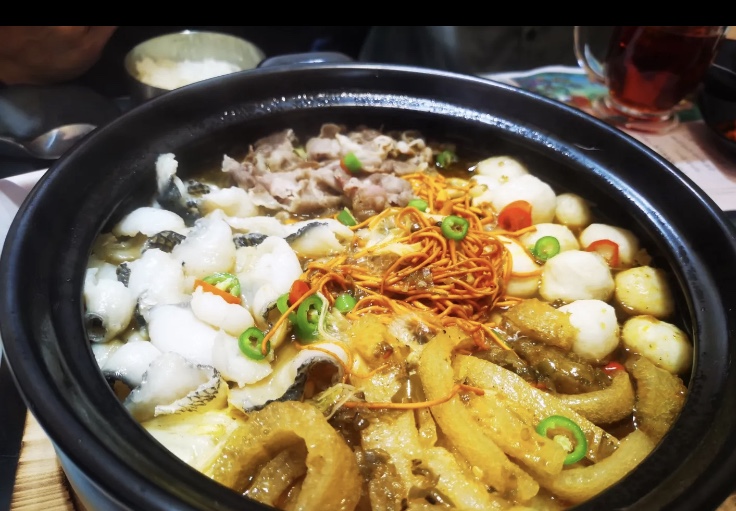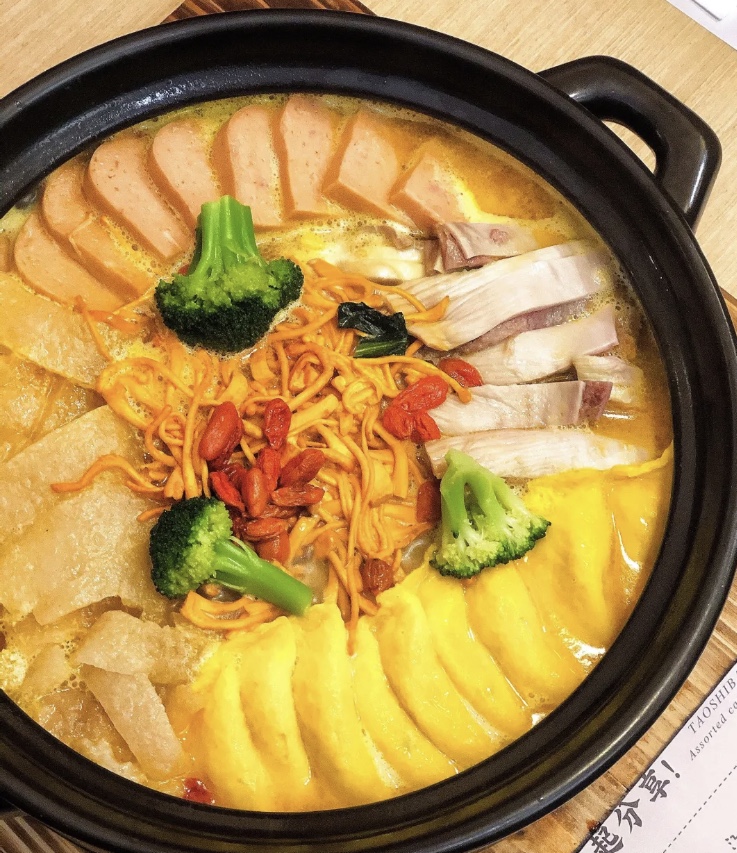Posted April 13, 2021
By SUMMER XIA
QINGDAO, China — When you walk into TaoShiba, you may feel a different atmosphere than a typical Chinese restaurant. The overall color of the restaurant’s design is light brown and green, which symbolizes a peaceful and serene mood.
Moreover, each table has a short curtain outside, and customers can choose to put it down to form a more private room for dining. So, customers could still have personal time with their friends or families when the restaurant is crowded.
In TaoShiba’s name, the kanji “仐” (Tao) is an unfamiliar kanji to most Chinese people. The restaurant chooses this kanji to represent both the restaurant’s missions and foods.
The top part of the kanji resembles a rooftop that covers the bottom part. Owners of restaurants use this kanji to imply that their restaurants could comfort and protect lonely people.
Likewise, the bottom part of “仐” means “10” in Chinese, representing 10 different types of food in TaoShiba.
Besides, as the top kanji looks bigger than the bottom kanji, it also resembles casseroles that consist of “10 different types of food” inside.
Just as the kanji “仐” (tao) in the restaurant’s name is expressed, TaoShiba wants to provide a home-feeling to its customers and a place to eat and rest for people who feel lonely.
Although the restaurant is not big and only has two waiters besides the manager, all staff work with great enthusiasm and passion. The waiter would introduce the dish to the first-time customers, make a suggestion according to their preference, and ask about their food suggestions after they finished. Besides, the manager sometimes would join the regular-visited customers’ table, like an old friend.
When you first try TaoShiba’s dish, you will be surprised about how big it is. The size also indicates one of its restaurant cultures: decreasing the loneliness and sharing with people you loved.
The basic idea is that the dish is too big to let one person finish, so you have to come with others to share this one dish.
There are six different types of assorted casseroles and four are the feature dishes. Moreover, TaoShiba associates those four feature dishes with four historical figures and uses various images to represent them to create a more unique and vibrant restaurant culture.
For example, TaoShiba associates the fish and lamb casserole with the artist Vincent van Gogh. The image of this dish is a goat sits on a big fish to draw his self-portrait. On the one hand, the goat and fish represent two main types of food in this assorted casserole; on the other hand, the contrast between those two different species emphasizes van Gogh’s uniqueness and the uncommon combination of fish and lamb in a food dish.
The fish and lamb casserole consists of fish balls, fish slices, lamb slices and different vegetables. Fish balls in most Chinese restaurants are made of lots of starch to achieve elasticity, and they taste more like a starch ball. However, TaoShiba’s fish ball is very tender and has a fresh taste close to fish. Likewise, the fish slice is so delicious that it can easily create a feeling of satisfaction when customers eat it.
Moreover, the most significant difference between Chinese casserole and the casserole from Western countries is that Chinese casserole is more watery and soupy. It is more like an assorted soup dish. In the fish and lamb casserole, the lamb and fish’s taste combine into a fresh and savory soup that customers cannot stop drinking.
Opposite to the fish and lamb casserole’s refreshing texture and delicate taste, the pork and egg dumpling casserole is more brothy and meaty.
It is the best choice for the meat lover, but customers probably would feel greasy after eating it for several bits.
So, to reduce the feeling of oily, TaoShiba has a combo for this casserole with a cup of tea and seaweed salad.
The refreshing taste of tea and seaweed salad’s sweet and tangy taste perfectly balances the pork’s greasy and heavy texture.
Another significant feature of TaoShiba is its inexpensive food price. Each dish, on average, is about ¥100 (about US$15), and each dish can be shared with two or three people. So, each person only needs to spend about ¥50 (US$7) per meal in TaoShiba.
In short, TaoShiba tries to establish a Neverland for food lovers by offering a tranquil and private space, pleasant and attentive service, warm and delicious dish, and affordable food price. As TaoShiba’s slogan “to make you happy,” its assorted casserole is a type of comfort food that can lessen people’s bad moods.
When customers first see the piping hot dish come to their table, the mouth-watering looks would automatically create a feeling of desire and lift people’s attitudes. The tasty soup then stirs into the rice and share different types of food from this big pot with the people you loved. You would feel physical satisfaction created by food and mental satisfaction by your friends and families’ company.
TaoShiba
Address: No.100 Liaoyang West Road, Qingdao, Shandong Province, China.
Telephone: +86 13954273165.
Recommended: The fish and lamb casserole; the Korean style assorted casserole; the pork and egg dumpling casserole. ¥88 – ¥108 ($13 – $16).
Price: $ (inexpensive).
Operation Time: Daily for lunch and dinner, from 10 a.m. to 9 p.m.
Reservations: Accepted.
Reviewer Rated: 4 out 5 stars.



